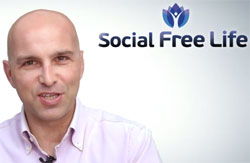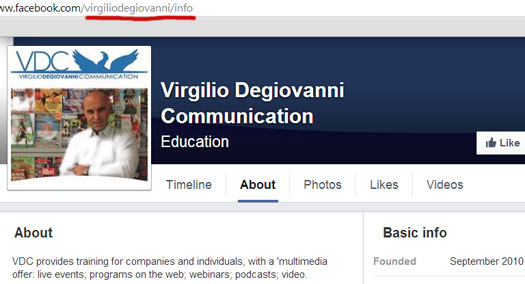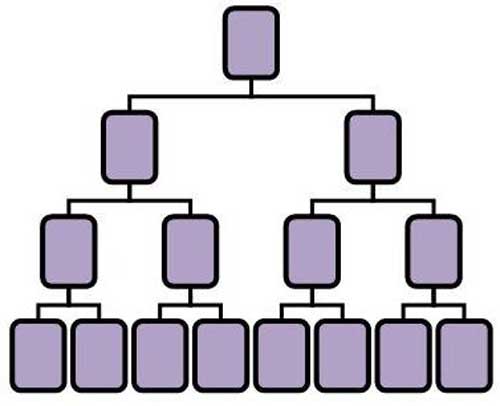Social Free Life Review: 877 EUR for a social network?
![]() Social Free Life launched in early 2014 and provide two addresses on their website, “legal” and “operative”, both in Malta.
Social Free Life launched in early 2014 and provide two addresses on their website, “legal” and “operative”, both in Malta.
The company names Virgilio Degiovanni as a Founder on their website, along with an anonymous group of individuals
who had the unique vision to start it in the first place. Industry investors with business acumen to support the relentless drive led Virgilio Degiovanni to bring Social Free Life Sharing to success.
No specific information (MLM or otherwise) on Degiovanni or his group of investors is provided.
 Degiovanni (right) is quite active on the internet, with his Twitter account revealing that he is based out of Milano in Italy. Given this, it would appear the Maltese addresses provided on the Social Free Life website are virtual mailing addresses.
Degiovanni (right) is quite active on the internet, with his Twitter account revealing that he is based out of Milano in Italy. Given this, it would appear the Maltese addresses provided on the Social Free Life website are virtual mailing addresses.
I’ve seen Malta pop up as a preferred business registration for a number of dubious European-based MLM companies recently, so make of that what you will.
On his Facebook page, Degiovanni associates himself with “Virgilio Degiovanni Communication”:

Degiovanni claims the company
provides training for companies and individuals, with a ‘multimedia offer: live events; programs on the web; webinars; podcasts; video.
Meanwhile Degiovanni would appear to be quite well known in Italy, warranting his own Wikipedia entry.
On it, Degiovanni is credited with launching something called “The Millionaire Network” in 1994. It seems to have been some sort of card discount scheme, not unlike what we still see floating around today (charging a fee for access to third-party discounts).
In 1996 Degiovanni expanded The Millionaire Network to encompass the Millionaire’s Market. Auto-translate is a bit iffy, but it seems this company was an attempt to offer retail product discounts through the company.
Following the launch of the Millionaire’s Market, ‘the project ran out in a matter of a couple of years.‘
In 1998 Degiovanni got involved in telecommunications and online ventures, going on to launch something called “Freedomland” in 2000.
Freedomland was founded in 2000 and owned by the same Degiovanni, is publicly traded on the New Market [9] . However, the stock market does not believe in Freedomland , and the stock falls to € 99.18 on the first day of listing 105.
Within a few months, the stock lose 90% of its value. For supporters of Degiovanni, it is the result of an act hostile speculative. To detractors, however, the share price Freedomland is too high. In fact, Freedomland is the first publicly traded company to mark the collapse of the New Market.
This led to charges being filed against Diogiovanni, which appear to have resulted in a conviction and jail time:
In 2001 Degiovanni is accused of illegal financial and false prospectus. According to the indictment, the actions Freedomland have been placed on the market at an artificially high price, € 105, due to a false prospectus, in which the number of subscribers was “inflated” were shown tens of thousands of subscriptions that reality had not yet been signed. In July 2001, the stock price had fallen to about 16 Euros.
The Court of Milan (sentenced) Degiovanni to ten months’ imprisonment, a negotiated sentence for the forgery of the listing prospectus of Freedomland . Thirty thousand investors have lost 92% of their investment, for a total of 315 million.
A whole bunch of non-MLM related stuff happened after that, with Degiovanni launching his Virgilio Degiovanni Communication company in 2010.
At some point he seems to have gotten involved in Xango, with his name being mentioned in an article covering the 2011 shutdown of Xango in Italy.
Degiovanni is cited as the “President” of FreedomLand and “among the first guru(s) of Multilevel Market(ing)” in Italy.
On January 3rd, Xango was shutdown by “the Italian AntiTrust organization” for fraudulent health claims and operating a compensation plan that focused on the recruitment of new affiliates. What Degiovanni’s specific role was within the company (affiliate or executive) was not clarified.
In any event, now in 2014 Degiovanni appears to be making a comeback in the MLM industry by way of Social Free Life.
Read on for a full review of the Social Free Life MLM business opportunity.
The Social Free Life Product Line
As the company name suggests, Social Free Life offer a social network service.
The network name appears to be “Social Free Life Sharing”. As per the Social Free Life website, the network encompasses your usual social network features as well as e-commerce functionality.
Access to the social network is bundled with Social Free Life affiliate membership, which ranges in price from 20 EUR a month (Daily Communicator) to a one off payment of 877 EUR (Pro Communicator).
The Social Free Life Compensation Plan
The Social Free Life compensation plan pays out weekly commissions via a binary and monthly via a unilevel. Commissions are paid out when new affiliates join the scheme, with shares in two bonus pools also on offer.
Binary Commissions
Weekly residual commissions in Social Free Life are paid out using a binary compensation structure.
A binary compensation structure places an affiliate at the top of two binary teams, left and right:

Positions in the binary teams are filled via recruitment (direct or indirect), with the binary able to extend down a theoretical infinite number of levels.
Commissions are paid out based on points generated in the binary. Points are generated when a newly recruited affiliate signs up and pays their membership fee:
- Basic Communicator (97 EUR) – 50 points
- Advanced Communicator (277 EUR) – 150 points
- Pro Communicator (877 EUR) – 400 points
At the end of the week, the total number of points generated on both binary teams is calculated and an affiliate is paid on their lesser team’s volume.
How much of a commission is paid out on the weaker team’s volume is determined by an affiliate’s membership rank:
- Rank A (join and pay affiliate membership fee) – 15%
- Rank B (recruit 3 affiliates) and above – 20%
The counted volume is flushed from the lesser team in its entirety, with the same subtracted from the stronger team’s volume total. Leftover volume is then carried over and the process repeats itself the following week.
A matching bonus is also available on the binary earnings of recruited affiliates, payable down three levels of recruitment:
- Rank B – 10% on personally recruited affiliates (level 1)
- Rank C (recruit 6 affiliates) – 20% on level 1 and 10% on level 2
- Rank D (recruit 9 affiliates) – 20% on level 1, 10% on level 2 and 5% on level 3
Unilevel Commissions
Monthly residual commissions are paid out using a unilevel compensation structure.
A unilevel compensation structure places an affiliate at the top of a unilevel team, with every personally recruited affiliate placed directly under them (level 1):

In turn, if any of these personally recruited affiliates go on to recruit new affiliates of their own, they are placed on level 2 of the affiliate’s unilevel team. If any level 2 affiliates recruit new affiliates, they are placed on level 3 and so on and so forth down a theoretical infinite number of levels.
Commissions are paid out as a percentage of the sales volume of affiliates in a unilevel team, with how much of a percentage determined by what level an affiliate falls in the unilevel team.
An affiliate’s own affiliate rank is also used to determine how many levels they are paid out on:
- Agent (recruit 1 affiliate and have a downline that generates over 100 volume points a month) – 10% on level 1
- Agent 1 Star (recruit 3 affiliates and have a downline that generates over 250 volume points a month) – 10% on levels 1 and 2
- Agent 2 Star (have a downline that generates over 350 volume points a month) – 10% on levels 1 to 3
- Pro Agent (have a downline that generates over 500 volume points a month) – 10% on level 1 to 4
- Pro Agent 1 Star (recruit 6 affiliates and have a downline that generates over 650 volume points a month) – 15% on level 1 and 10% on levels 2 to 4
- Executive Agent (have a downline that generates at over 800 volume points a month) – 15% on levels 1 and 2 and 10% on levels 3 and 4
- Executive Agent 1 Star (have a downline that generates over 1000 volume points a month) – 15% on levels 1 to 3 and 10% on level 4
- Executive Agent 2 Star (recruit 9 affiliates and have a downline that generates over 1500 volume points a month) – 15% on levels 1 to 4
- Executive Agent 3 Star (have a downline that generates over 2000 volume points a month) – 20% on level 1 and 15% on levels 2 to 4
- Executive Agent 4 Star (recruit 12 affiliates and have a downline that generates over 3000 volume points a month) – 20% on levels 1 and 2 and 15% on levels 3 and 4
- Executive Agent 5 Star (recruit 15 affiliates and have a downline that generates over 5000 volume points a month) – 25% on level 1, 20% on levels 2 and 3 and 15% on level 4
- Executive Agent 6 Star (recruit 18 affiliates and have a downline that generates over 8000 volume points a month) – 25% on levels 1 to 3 and 20% on level 4
- Executive Agent 7 Star (27 affiliates and have a downline that generates over 10,000 volume points a month) – 25% on levels 1 to 4
Note that the downline volume requirements count sales volume only from an affiliate’s first four unilevel levels.
Generation Bonus
Social Free Life’s Generation Bonus kicks in at the Pro Agent rank, and extends unilevel commissions down a theoretical infinite depth.
In the Generation Bonus each unilevel recruitment leg is treated independently of the others, with a generation defined as the first affiliate found after the fourth level that is at the same or higher rank as the affiliate being paid.
Eg. If the first Pro Agent or higher ranked affiliate is on level 7 of a unilevel leg, all the affiliates in that leg between level 4 to 7 count as the first generation. A second generation would be formed when another Pro Agent or higher ranked affiliate is found further down in the same leg.
The Generation Bonus starts at the Pro Agent affiliate rank and pays out as follows:
- Pro Agent – 0.5% on the first generation
- Pro Agent 1 Star – 1% on the first generation
- Executive Agent – 1.5% on the first generation
- Executive Agent 1 Star to 3 Star – 2% on the first generation
- Executive Agent 4 Star to 6 Star – 1% on the first generation and 2% on the second
- Executive Agent 7 Star – 1% on the first generation, 2% on the second and 3% on the third
Global Leadership Pool
The Global Leadership Pool is paid out quarterly via shares.
Shares are allocated to Social Free Life affiliates based on their affiliate membership rank:
- Agent – 1 share
- Agent 1 Star – 2 shares
- Agent 2 Star – 3 shares
- Pro Agent – 4 shares
- Pro Agent 1 Star – 5 shares
- Executive Agent – 6 shares
- Executive Agent 1 Star – 8 shares
- Executive Agent 2 Star – 10 shares
- Executive Agent 3 Star – 12 shares
- Executive Agent 4 Star – 15 shares
- Executive Agent 5 Star – 20 shares
- Executive Agent 6 Star – 25 shares
- Executive Agent 7 Star – 30 shares
The Executive Bonus Pool (below) is made up of 2% of the global affiliate membership fees paid to the company. In their compensation plan material, Social Free Life do not disclose how the Global Leadership Pool is funded.
Executive Bonus Pool
The Executive Bonus Pool is made up of 2% of the global affiliate membership fees paid to Social Free Life.
The Pool is paid out monthly via shares, with how many shares an affiliate receives of the pool determined by their affiliate membership rank:
- Executive Agent 5 Star – 1 share
- Executive Agent 6 Star – 3 shares
- Executive Agent 7 Star – 8 shares
Joining Social Free Life
Affiliate membership to Social Free Life starts at 20 EUR a month and caps out at 877 EUR.
- Daily Communicator – 5 EUR a week (20 EUR a month)
- Basic Communicator – 97 EUR
- Advanced Communicator – 277 EUR
- Pro Communicator – 877 EUR
The social network is offered with all levels of affiliate membership, with additional marketing tools and training thrown in at the higher levels.
Conclusion
I think the easiest way to address the issue of legitimacy within Social Free Life is to ask the question: “Who is going to pay 20 EUR a month to access to a social network?”
As far as I can see, there’s no retail offering with Social Free Life, meaning the social network itself is just going to be full of affiliates pushing the opportunity (to generate volume points to get paid on).
Functionality-wise the social network looks to be like any other, with any additional marketing features offset by the fact that affiliates will just be marketing to other affiliates.
That in itself isn’t a bad thing, but in an MLM opportunity it’s just going to wind up being a spam fest.
Not withstanding that in MLM you need to be selling something to retail customers (non-affiliates), and that key component seem to be absent in Social Free Life.
Looking at the bigger picture, the social network MLM niche has a notorious reputation for failure. Not because the companies that came before Social Free Life failed to “crack the code” or any other such hogwash a Social Free Life affiliate might tell you, but because they failed to provide value to non-affiliates.
With so many free alternatives around, the notion that people are going to pay for a social network (for any purpose) is laughable. And anyone should be able to determine that affiliates aren’t coughing up close to 800 EUR for anything but participation in the compensation plan.
All that you wind up with is a recruitment-driven opportunity, paying out commissions based on how many affiliates are recruited, how much they spend on membership and in turn how many affiliates those recruited can recruit.
A business model that is otherwise known as a pyramid scheme.
That Virgilio Degiovanni has a history with Italian regulators is somewhat telling, and I believe the reason he’s incorporated Social Free Life in Malta.
Will it be enough to fend them off if they catch wind of the company and decide to investigate?
It’s probably not worth taking the risk to find out…


Doesn’t matter where he is. Malta is part of EU and part of Eurozone, and so is Italy. Common laws, esp. on pyramid schemes.
The question is part of regulators, how diligent are they, and it seems they know quite well what Degiovanni are up to.
@Kchang…. Common Laws in the Eurozone? Talk about American ignorance.
No borders (Schengen), and even that is iffy; common currency but by no means a common set of laws. Brussels is bloated, but not all that effective.
To join the EU the country must pledge to pass a common set of laws, translated to local language, as agreed by EU. Each country may adopt its own name for the law, but it’s based on the same template from the EU.
I’ll thus refer you to “Consumer Protection Co-operation Regulation”, as per Malta Law CHAPTER 378 CONSUMER AFFAIRS ACT.
If you say Malta doesn’t enforce such laws effectively that is a different matter, but the law is there.
Part VII of such Act specifically refers to illicit schemes such as pyramid schemes.
Not common laws in general, but similar commercial laws. It’s based on the “4 Freedoms” = free movement of goods, capital, people and services in the internal market (across borders).
NOLINK://en.wikipedia.org/wiki/Internal_market